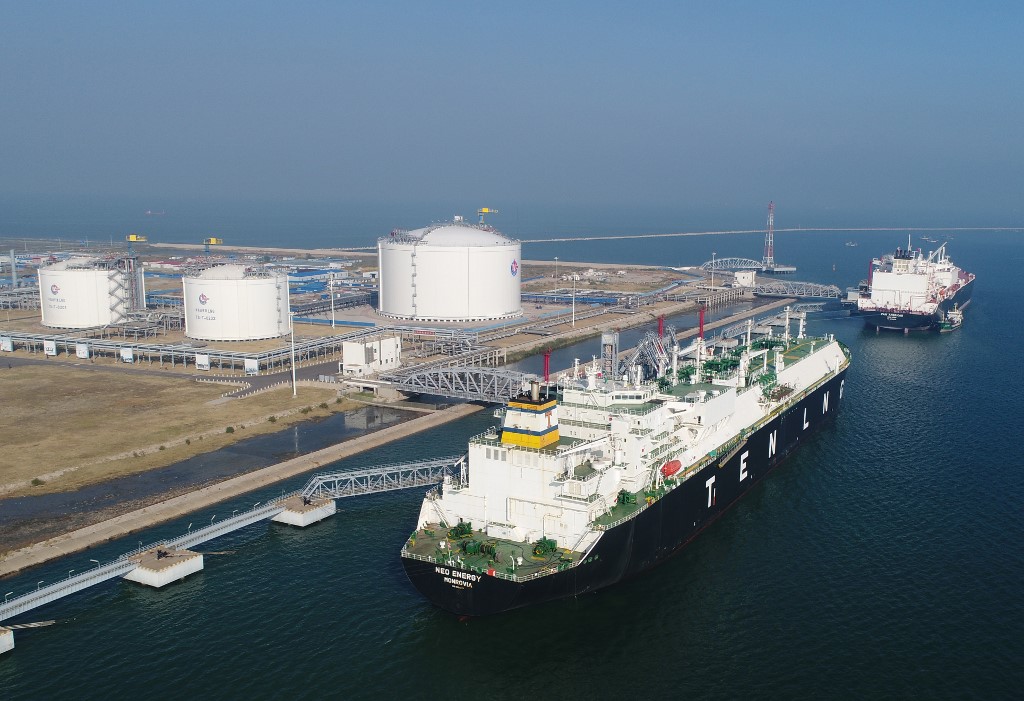Construction has got under way on what will be China’s largest privately-held liquefied natural gas (LNG) terminal, further loosening the stranglehold of the country’s Big Three majors.
The country’s natural gas sector has morphed from a tightly-held monopoly by the so-called Big Three (CNPC, Sinopec, and CNOOC) to one now with increasing market liberalisation and open competition – but this has taken years and has been hard fought by independent energy players, both private and state-run.
That a private Chinese company can even build its own LNG terminal shows how far the country’s gas sector has come.
Read more: Crypto fund inflows soar by 600% to top $5.6 billion this year
The latest salvo by the independents came on Monday. Huaying Natural Gas, a private company, began construction on its own liquefied natural gas (LNG) import terminal in the port city of Chaozhou in Guangdong, a coastal province in south-east China, near Hong Kong. With a capacity of some 6 million tonnes per annum (mtpa), it will be the country’s largest privately-held LNG terminal to date.
The cost of the terminal’s first phase has been pegged at some 8 billion yuan (US$1.22 bn), while it’s expected to start operations in 2023. Three gas storage tanks with a capacity of 200,000 cubic meters each will be built alongside the first stage of the project, and another four tanks of the same capacity are planned for phase two, according to a China Daily Report.
Huaying said it also plans to invest 4 billion yuan more to build ancillary facilities at the terminal and another 2.3 billion yuan on top of that for a LNG carrier, also in phase two.
The project will be the eighth terminal in the province, while two more projects are also currently under construction.
STATE-RUN BEHEMOTHS
Until recently, energy players had to face tough negotiations from the Big Three for third party access to import LNG to their facilities. Resistance was the norm, leaving independents and private companies alike at the mercy of these state-run behemoths.
However, by mid-2018 the situation on the ground finally started to change. That August, independent gas distribution company ENN Group opened China’s first privately-run LNG import facility, located in Zhejiang province, with capacity of 3 mtpa.
Gas distribution companies and city gas companies, including Guanghui Energy, JOVO Group and Beijing Gas Group, as well as power utilities like Huadian, Huaneng and Guangdong Development also took advantage of market reform to enter China’s LNG sector.
Beijing had finally opened up the country’s LNG sector by not only granting third-party access to the Big Three’s terminals, but by liberalising domestic gas pricing, and even promoting LNG trading hubs.
CONTINUED PUSH
Continuing the push, more private-owned LNG facilities have been built despite higher tax rates and cumbersome approval processes, all the while helping the country break up the Big Three’s monopoly.
Beijing energy planners were already under pressure to liberalise gas and LNG markets given the country’s seemingly insatiable gas consumption. The opportunity to trade the arbitrage between lower spot LNG prices in the region, and regulated gas hub prices and long-term LNG contracts linked to an oil-indexation formula, also incentivised the change.
China is the world’s largest energy consumer, its largest oil importer and its largest natural gas user. The country of more than 1.4 billion people bypassed legacy LNG importer South Korea in 2017 to take the second LNG importing slot, and is poised to eclipse LNG import leader Japan around 2022 for the top spot.
CARBON-NEUTRAL PLEDGE
As such, China’s gas and LNG infrastructure will not only help meet gas supply needed to sustain its economic growth, but help Beijing meet its ‘carbon neutral by 2060’ pledge made by Chinese President Xi Jinping in September.
Gas, for its part, is the cleanest burning hydrocarbon, and is earmarked to represent at least 15% of the country’s energy mix by 2030, with further earmarks going forward. More coal to gas switching, however, is needed to help rein in the country’s greenhouse gas emissions (GHG), the world’s highest – mostly due to its over-reliance on coal needed for power generation.
China’s revamped gas and LNG sector has also been helped by PipeChina, a newly formed state-backed entity that took over oil and gas pipelines and storage facilities from (PetroChina, CNPC’s listed arm) and oil major Sinopec, in return for cash and equity in the pipeline company.
PRIVATE IMPETUS
PipeChina started leasing third party access to its vast distribution lines, terminals and storage facilities in October. The move has also helped China’s independent gas players ramp up their LNG purchases and will also give even more impetus for additional privately held LNG infrastructure to be built.
For 2020, LNG imports by non-state companies in China is projected to increase some 40% year-on-year, reaching 11 million tonnes, and amounting for more than 17% of the country’s total LNG purchases, said Chen Zhu, managing director of Beijing-based consultancy SIA Energy.
With greater access to distribution networks, they are now incentivised to build their own import terminals that could account for 40% of the country’s LNG receiving capacity by 2030, versus 15% now, he added.
Going forward, these independent players, both private and state owned, will continue to erode the Big Three’s gas and LNG market share.
























